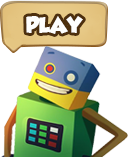Discover JavaScript in the Ocean
Let's learn everything about movements through loops, conditionals and data alignment structures in the Journey through the Ocean with JavaScript.
When we finish this adventure we will have reached the middle of our journey. We can do this! It's time to get to know the sea inhabitants well!
The plan is to go ahead and make note of how many patches of coarse sand we step on while we move on to pick up this sea shell. Easy!
We need to move forward and count the patches with different sediments (coarse sand and sea urchins), adding the number of different patches that we step on. At the end, take note of this number.
Right, let's observe that stingray. To do this, let's go to the cell where it is. We need to count the number of patches of coarse sand and sea urchins we go over. Not just that! We need to note what is "coarse sand" if the number of patches of coarse sand is bigger than the number of patches of sea urchins. If we discover that there are more patches of sea urchins, then we need to write a a note saying "sea urchins".
We need to watch that stingray and count the number of patches of coarse sand and sea urchins that we go through. If we find more patches of coarse sand we need to turn right to observe the stingray. Otherwise, if we find that there are more patches of sea urchins than coarse sand, then we will turn left to watch the stingray.
As we did before, when we get to the end of the adventure, we will need to explore while we write another letter in the sand. Now let's watch some crabs and write another letter to celebrate our excitement at getting to know the aquatic setting.
Discover JavaScript in the Ocean
Let's learn everything about movements through loops, conditionals and data alignment structures in the Journey through the Ocean with JavaScript.
